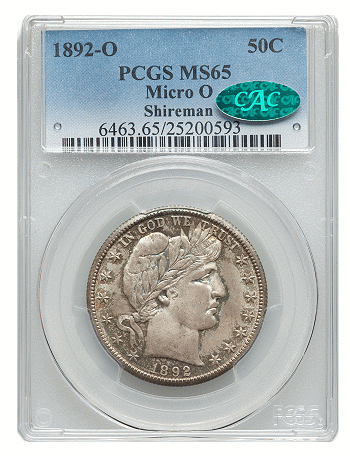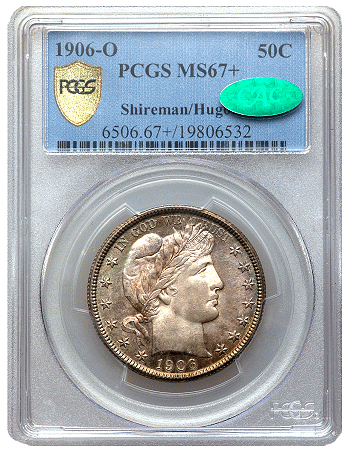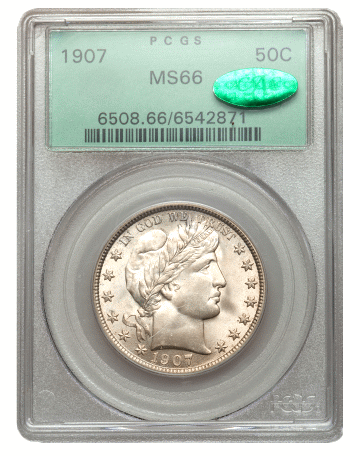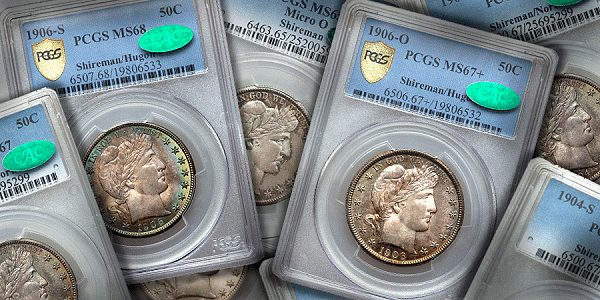News and Analysis regarding scarce coins, coin markets, and the coin collecting community, #307
A Weekly CoinWeek Column by Greg Reynolds…..
The Barber half dollar collection assembled by Dr. Peter Shireman is, by far, the finest intact set that is known to the coin community and was built during a period of more than twenty years. Shireman’s set will be the featured specialized collection in the Heritage auction at the January 2016 FUN Convention in Tampa.
Barber half dollars date from 1892 to 1915. Although no regular issue, Barber halves are rare in absolute terms, there are many condition rarities in the gem grade range. Coins that grade from MS-65 to MS-68 are traditionally thought of as being gem uncirculated or gem quality ‘mint state.’ Moreover, many gem Barber halves have naturally toned in a colorful and cool manner, partly from being stored in the kinds of coin albums that were popular during the middle of the 20th century. A few Barber halves in Shireman’s set are spectacular.
 Shireman’s 1892-‘Micro O’ half is a gem grade representative of a rare and unusual variety. It and his 1904-S are probably the two most valuable coins in Shireman’s set. The 1904-S is the key Barber half in high grades.
Shireman’s 1892-‘Micro O’ half is a gem grade representative of a rare and unusual variety. It and his 1904-S are probably the two most valuable coins in Shireman’s set. The 1904-S is the key Barber half in high grades.
Dr. Shireman has a PCGS graded and CAC approved, MS-67 1904-S, which was formerly in the epic collection formed by the Norweb family. It was auctioned by Bowers & Merena (of New Hampshire) during November 1988 in New York.
I have examined all of the PCGS graded MS-66 and MS-67 1904-S halves. One of the NGC certified pieces ‘crossed over’ to PCGS and may be a duplicate listing. There seems to be five or six different 1904-S halves that are PCGS or NGC graded in the MS-66 to -67 range. In my view, this Norweb-Shireman 1904-S half is the second finest known. It could certainly bring a six figure price in January.
Barber halves in general are not expensive in the context of 19th century silver coins. In addition to 1892-‘Micro O’ halves, it is just the top ranked representatives of better dates that are worth vast sums. Indeed, more than 98% of surviving Barber halves are reasonably priced.
A set of gradable Barber Halves, including all year and mintmark combinations, may be purchased for less than $250 per coin. Many Fine to Very Fine grade coins are available for less than $100 each. The following dates may not be available in Fine-12 or higher grades, however, for less than $250 per coin: 1892-O, 1892-S, 1893-S, 1896-S, 1897-O, 1897-S, 1904-S, 1914 and 1915. These, though, can be acquired in Good-04 grade for below $250 per coin.
For less than $500 each, a collector building a set of Barber half dollars has considerable flexibility in regard to circulated grades. Another past discussion was about the costs and practicality of assembling a set AU-55 to MS-63 grade of Barber halves, some of which will cost more than than $1000 each. (By clicking on words in blue, past articles and other references may be accessed.)
 From 1892 to 1915, there are seventy-three dates (including U.S. Mint locations) in the series of Barber half dollars. These were struck in Philadelphia, Denver, New Orleans and San Francisco. Barber half dollars that were produced in Philadelphia never have mint marks.
From 1892 to 1915, there are seventy-three dates (including U.S. Mint locations) in the series of Barber half dollars. These were struck in Philadelphia, Denver, New Orleans and San Francisco. Barber half dollars that were produced in Philadelphia never have mint marks.
It is educational and often enjoyable for collectors who seek coins that grade less than 65 or even less than VF-25 to learn about and view gem quality coins in series of interest. To attain an understanding of the physical characteristics of coins, relevant history and the culture of coin collecting, it is beneficial to learn about the whole grade range from Poor-01 to MS-68.
It is generally believed that there are no business strike Barber halves that grade above MS-68. The Hugon 1906-S that was formerly NGC graded as MS-69 is now PCGS graded as MS-68 and is in Shireman’s collection. On January 12, 2005, the Hugon 1906-S was auctioned for $46,000.
While in a PCGS holder with a “MS-68” grade, the Hugon-Shireman 1906-S was CAC approved. I prefer the Hugon-Shireman 1906-S to the famous Duckor 1905, which is PCGS graded as “MS-68+.”
The few Proof Barbers that have been PCGS or NGC graded as “69” are a topic for a future discussion. A colorful 1899 half was in the Gene Gardner Collection. It is NGC certified as “Proof-69” and has a CAC sticker. That 1899 half realized $44,062.50 on October 27, 2014.
No More Proofs Among Business Strikes
Gem quality, Philadelphia Mint, Proof Barber half dollars tend to be fairly easy to obtain. Since around 1980, the collecting of Proofs and the collecting of business strikes of the same series have been considered to be two very different pursuits. A tradition of mixing Proofs and business strikes in the same sets of gem quality coins was largely replaced by another tradition, which prohibits such mixing.
 As so many of the great collectors of the past mixed Proofs and business strikes in the same sets, they often ignored business strike Barber halves of Philadelphia Mint dates. Superb Proofs of most of these dates are easy to acquire. Proofs were then considered to be superior to business strikes. Now, most collectors regard Proof Barber coins and business strikes to be completely separate entities.
As so many of the great collectors of the past mixed Proofs and business strikes in the same sets, they often ignored business strike Barber halves of Philadelphia Mint dates. Superb Proofs of most of these dates are easy to acquire. Proofs were then considered to be superior to business strikes. Now, most collectors regard Proof Barber coins and business strikes to be completely separate entities.
It is thus difficult to compare gem sets of Barber halves that were assembled before 1980 with those that have been completed over the last fifteen years. It is often much more difficult to find a 66 grade business strike of many Philadelphia Mint dates than it is to find a 66 grade Proof of the same date. For example, it would not be fair to count a Proof-66 1907 half in the same way an MS-66 1907 would be counted. This matter is further discussed in my article on 1904 Barber half dollars, and in my series on Dr. Duckor’s Barber halves in 2010.
Although my research is ongoing and formulations are subject to change, I have conceptualized and ranked the all-time greatest sets of business strike Barber halves. I attended the sales of the Barber halves of Gardner over the last two years, of Duckor in 2010, of Dale Friend in 2009, of Hugon in 2005, of Thaine Price in 1998, and of Eliasberg in 1997. Although I attend fewer sales in the Internet age, I carefully examined around two-thirds of Greensboro’s Barber halves and I recently inspected Shireman’s set.
Here are my tentative ranking for the all-time greatest sets of Barber halves: 1) Steven Duckor; 2) “Greensboro”; 3) Gene Gardner; 4) Thaine Price; 5) Dale Friend; 6) Peter Shireman; 7) John Hugon; 8) Louis Eliasberg; 9) Norweb Family; and 10) Emery-Nichols.
The Emery-Nichols sale was before my time. That auction was conducted by Bowers & Merena (of New Hampshire) in 1984. David Akers and Charlie Browne attended. I had access to their respective interpretations of the coins. Dr. Duckor and I, separately, have seen many of the Emery-Nichols Barber halves over the years, and I spent much time discussing them with him. He had earlier discussed Emery-Nichols coins with Akers who Duckor knew very well.
 Dr. Steven Duckor is one of the most accomplished and sophisticated collectors of all time. He acquired many of his Barber halves when the firm of David Akers auctioned the collection of Dr. Thaine Price in May 1998. It was Dr. Duckor who encouraged Dr. Price to collect Barber halves and 20th century gold coins. They were colleagues as medical doctors before being fellow coin collectors.
Dr. Steven Duckor is one of the most accomplished and sophisticated collectors of all time. He acquired many of his Barber halves when the firm of David Akers auctioned the collection of Dr. Thaine Price in May 1998. It was Dr. Duckor who encouraged Dr. Price to collect Barber halves and 20th century gold coins. They were colleagues as medical doctors before being fellow coin collectors.
John Hugon’s Barber dimes, quarters and halves were auctioned by Heritage on January 12, 2005. Even without an 1894-S dime, the Hugon Collection rivals the Barber portions of the Eliasberg and Norweb collections.
Gene Gardner’s Barber coins, in sum, may be the best of all. I have written a seven part series on the Gene Gardner Collection.
Dale Friend is one of the most active and widely recognized of all living collectors. He has assembled many impressive sets of classic U.S. coins. Dale’s set of Barber halves was auctioned in January 2009.
While formulating the above ranking of sets, I ignored the 1892-‘Micro O’ half as it is a variety of interest to specialists, rather than an issue that most collectors would focus upon. Also, I tend to weigh originality much more heavily than graders at PCGS and NGC. At grading services, obviously and somewhat recently dipped-white coins are often assigned very high grades, even as high as “MS-68”! Grade-inflation and coin doctoring are relevant, too. For multiple reasons, my rankings differ from rankings derived from grades assigned by PCGS or NGC.
Shireman’s collection is the “current finest” set of Barber halves in the PCGS set registry. It is not practical to review the entire Shireman set here. Four of the extreme condition rarities in 66 to 67 grades are discussed: 1894-O, 1895-S, 1901-S and 1907. Shireman’s representatives of these dates are impressive and particularly important. His amazing 1906-S has already been mentioned.
Hugon-Shireman 1894-O
The Hugon-Shireman 1894-O is one of the greatest coins in the set. It is PCGS graded as MS-66+ and is CAC approved. Though it has the eye appeal of a higher grade coin, the Hugon-Shireman 1894-O has more than a few noticeable contact marks on Miss Liberty and in the right obverse field. The overall grade balances out in the high end of the 66 range, which is extremely impressive for an 1894-O. Moreover, when tilted under a lamp, fully mirrored fields become apparent. It is not a special striking, but it is very cool. The frosty head of Miss Liberty contrasts nicely with dynamic fields. The russet toning about the outer design elements adds to the appeal of this coin.
In my view, the Duckor-Friend-Price-Emery-Nichols 1894-O is very similar in quality to the Hugon-Shireman 1894-O. As the Duckor-Friend piece is PCGS graded as “MS-67” and the Hugon-Shireman 1894-O is PCGS graded as MS-66+, the Hugon-Shireman 1894-O may be a much better value. Certainly, the Hugon-Shireman 1894-O is an attractive target for a serious collector of pristine gem Barbers.
Duckor-Price-Shireman 1895-S
Dr. Shireman has the 1895-S that was previously in the Steven Duckor and Thaine Price Collections. It is PCGS graded as MS-67 and CAC approved. It has toned marvelously and scores extremely high overall in the category of originality. In August 2010, this same coin realized $50,312.50, probably a record price for an 1895-S half dollar.
The Hugon 1895-S is NGC graded as MS-67. It was acquired by Gene Gardner in 2005 and sold for $25,850 in the Gardner I sale on June 23, 2014.
Although Charlie Browne and Dr. Duckor figured that the Hugon-Gardner 1895-S does not merit a MS-67 grade, and I am now suggesting that it is unlikely to receive a CAC sticker while certified as MS-67, I have mixed feelings about it, which are mostly positive. The Hugon-Gardner 1895-S is unusually difficult to grade. Though uneven, the toning is cool and stable. If the toning is natural, the Hugon-Gardner 1895-S has not been properly understood by experts who I know. It may have been kept in a ‘normal’ closely fitting cardboard album for years.
In any event, the Duckor-Price-Shireman 1895-S is probably the finest known. The Hugon-Gardner 1895-S may possibly be the second finest. The PCGS graded MS66 and CAC approved Greensboro 1895-S could be the third finest known. Dale Friend had a PCGS graded MS-65 1895-S, without a CAC sticker. The difficulty of finding a MS-66 or higher grade 1895-S half is noteworthy.
Shireman 1901-S
The PCGS graded MS-66 1901-S is one of the more under-appreciated coins in Shireman’s set. Three are PCGS graded as MS-66 and two are PCGS graded as MS-67. A single 1901-S half is NGC graded as MS-67. One 1901-S half is PCGS graded as MS-67+. This total of seven probably does not amount to seven different coins.
CAC has approved two 1901-S halves at the MS-66 level, including the Shireman coin, and none at a higher level. The other CAC approved MS-66 1901-S was in the Dale Friend Collection and it brought $48,875 in January 2009. A lesson to be learned here is that a coin that is certified as grading MS-66 may be of higher quality than coins of the same date that are certified as grading MS-67.
Gene Gardner had two 1901-S halves that are relevant to this discussion. Gene’s PCGS graded MS-66 1901-S rates in the ‘low end’ of the 66 range, at best. The $15,275 result in October 2015 is consistent with the true nature of the coin
.
Gardner’s PCGS graded MS-67 1901-S has too much of a ‘white-dipped’ appearance for my taste. Undoubtedly, others like it. The $30,550 result on June 23, 2014 was an unsurprising price ‘for the holder,’ though clearly lower than the minimum a true MS-67 grade 1901-S half would have then realized.
Greensboro had the Duckor-Emery-Nichols 1901-S, which is PCGS graded as MS-67+. This 1901-S brought $51,700 in August 2015, less than the $86,250 result in August 2010, which was extremely strong. It does not have a CAC sticker.
In January 2008, while coin markets were booming, the NGC graded MS-67 Eliasberg 1901-S brought $37,375. In January 2011, the same Eliasberg 1901-S sold for $25,388.55. On both occasions, if most relevant bidders had regarded its grade as really MS-67, it would have sold for a greater amount. During the last ten years, a mid range to high end MS-67 grade 1901-S half, if one exists, would have been worth at least $47,500, maybe as much as $110,000!
In January 2008, I found its grade to be in the low end to the middle of the MS-66 range. At an earlier time, Charlie Browne graded it a fraction of a grade increment higher than I did in 2008.
The Eliasberg 1901-S has the technical characteristics of a MS-67 grade coin and the eye appeal of a MS-65 grade coin. I suggest that it would never receive a CAC sticker while in a holder with a MS-67 assignment.
When Dale Friend’s 1901-S, which is PCGS graded MS-66 and not a candidate for an upgrade, brought $48,875 in January 2009, coin markets were much lower than they were in January 2008, January 2011, June 2014 or August 2015. To an extent, that $48,875 result was an above-market result, strong, but it was not an extremely strong price.
I was at the auction and Friend’s halves tended to bring prices that were consistent with the expert interpretations of the quality of the respective coins. Friend’s PCGS graded “MS-66” 1901-S is about equal to the NGC graded “MS-67” Eliasberg 1901-S and is of higher quality than the PCGS graded “MS-67“ Gardner 1901-S. The just cited auction results by themselves do not conclusively demonstrate such condition rankings, but constitute circumstantial evidence that PCGS graded MS-66 grade coins may be of higher quality than PCGS graded MS-67 grade coins of the same issue.
The Shireman 1901-S is the finest that I have seen, superior to the Friend, Gardner and Eliasberg 1901-S halves. In my view, the Shireman 1901-S scores highly in both the originality and technical categories. Its grade is near the MS-67 border. While it is not one of the prettiest halves in the Shireman set, it is an excellent coin, stunning for a 1901-S half. Indeed, most prospective bidders are probably not aware of the relative quality and overall importance of the Shireman 1901-S half dollar.
Duckor-Shireman 1907
A 1907 half in MS-64 or MS-65 grade is not that hard to find. In grades above MS-65, however, 1907 business strikes are extreme condition rarities. PCGS reports grading four as MS-66, perhaps not all different coins, zero as MS-66+, zero as MS-67, and the Duckor-Shireman 1907 as “MS-67+.” The Duckor-Shireman 1907 is CAC approved.
 The Duckor-Shireman 1907 brought $28,750 back in January 2004. In August 2010, it commanded $50,312.50
The Duckor-Shireman 1907 brought $28,750 back in January 2004. In August 2010, it commanded $50,312.50
Hugon had a PCGS graded MS-65 1907, which Charlie Browne regarded as “having some originality, [though] was nothing special.” Dr. Duckor did not rave about it.
The Greensboro-Friend 1907 is PCGS graded MS-66, and does not have a CAC sticker. It brought $2585 in August 2015 and it will be offered again in January, from an unnamed consignor. Surprisingly, someone removed it from its relatively old PCGS holder, with an explicit Friend pedigree, and had it placed in a current standard PCGS holder without mention of any pedigree.
Gene Gardner certainly recognized the importance and neatness of 1907 business strikes. Gene had at least four that were PCGS or NGC graded MS-65 or MS-66.
One of two PCGS graded and CAC approved MS-66 1907 halves in the Gardner Collection brought $3525 on October 28, 2015. My view that it was overgraded is supported by the fact that Gardner’s other PCGS graded MS-66, and CAC approved, 1907 sold for $7637.50 on June 23, 2014 in the Gardner I sale, more than twice as much. It was not a candidate for a MS-67 assignment and market prices for 1907 halves did not fall by more than 50% in sixteen months!
The Gardner 1907 that sold in June 2014 is of significantly higher quality than the Gardner 1907 that in October 2015, although both are PCGS graded “MS-66” and CAC approved.
The Duckor-Shireman 1907 towers above the other 1907 business strikes that I have seen. It has wonderful orange-russet peripheral toning. The creamy blue-gray head of Miss Liberty is nicely complemented by green tints in the inner fields. The reverse is indescribably cool and has the eye appeal of a 68 grade coin. The obverse is not quite as terrific, though no expert could fairly doubt a solid 67 grade overall for this coin. It is superb. This is one of several wondrous coins in the Shireman set of Barber halves.
©2015 Greg Reynolds






Nice job Greg! sd
Great read on these slabbed barbers and I’m a dealer from nj and have a few circ sets of barber halves and had some trouble with some of the better dates 92-0 97-0 etc I would like to someday put a xf + set of barber halves ….If possible could I be put on some kind of email list so I could possibly purchase a common date barber half in 65
It will be interesting to see what these pieces sell for as demand for Barber halves has been down now that all of those collectors who were building sets at pretty much the same time, as Greg as noted, have all sold. Could be a good buying opportunity